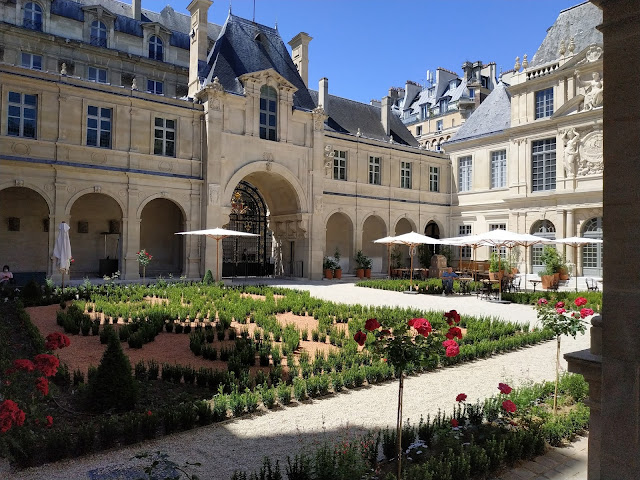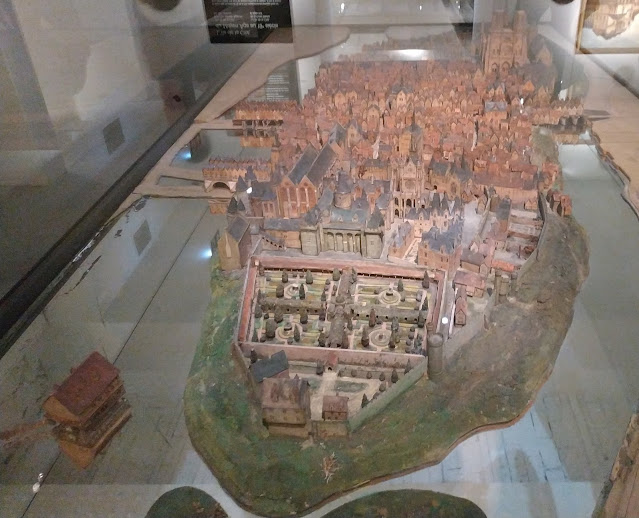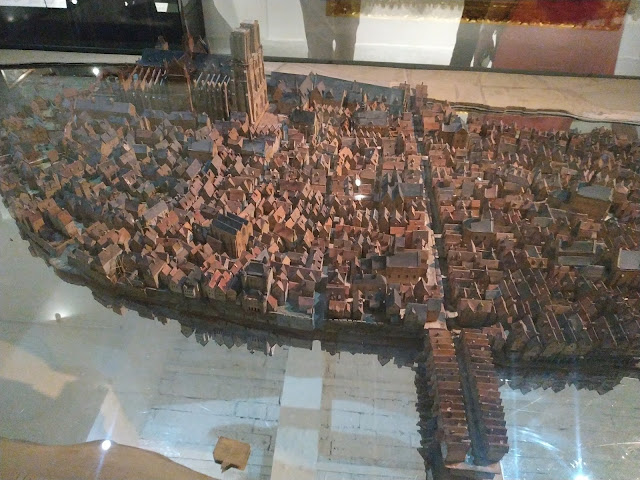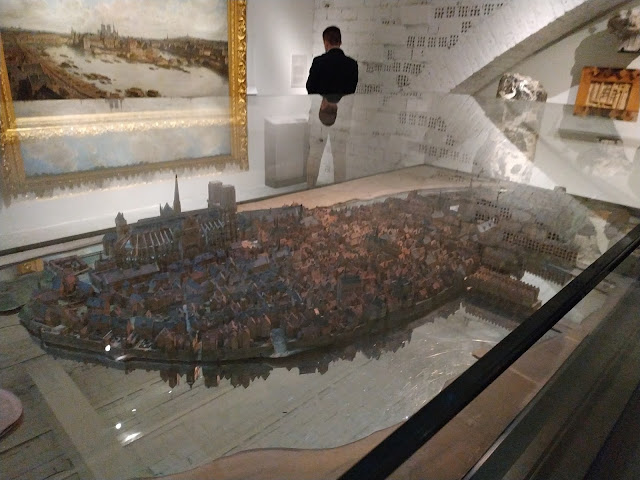Revisiting Paris’s history museum
Imagine air so cold it takes the feeling from your fingertips. This is the kind of weather that always comes to mind when I think of Paris’s history museum, le musée Carnavalet.
When I was a student here in Paris, a friend and I often used to stroll around the beautiful Marais neighborhood. When we got cold in winter, the musée Carnavalet was a warm refuge for us. The seemingly endless permanent collection rooms were heated and free, and full of amazing, often very strange objects.
Housed in two old hôtels particuliers (mansions built in the 16th to 18th centuries that are a signature of Marais architecture), the museum possesses an eclectic collection of items tied to Paris’s history.
Some are fairly expected: paintings, maps, charts, city seals and street signs, for instance. Others, though, veer towards the odd. There’s Voltaire’s surprisingly tacky chair, a slipper that probably belonged to Marie-Antoinette, a model of the Bastille carved from a stone of the actual Bastille after its demolition, and quite a large tuft of hair from famous French letter writer Madame de Sévigné, who lived here when the museum was a grand residence, in the 17th century.
But these weird objects also perfectly symbolize the history of the City of Light. So many strange, extraordinary, and even somewhat miraculous things have happened here, after all. And so it is with anywhere in the world. History is great because it can be so weird. Still, Paris does have an abundance of strange stories and objects tied to it in particular.
When I first came to live in Paris, visiting the musée Carnavalet felt like you were visiting the house of some eccentric old friend who collected little bits of everything. The place was enormous and somewhat difficult to navigate, no matter how many times you’d been there, with something around the corner or tucked into a niche that caught your eye and often surprised you.
It’s been a long time since I was a college student in Paris, but I thought the musée Carnavalet would stay in my life for good. It’s such a part of Paris for me that I even wanted to include it in Hearts at Dawn. But as I’ve learned, historical fiction writers’ plans often go awry due to, well, history itself.
The museum didn’t open until 1880, ten years after Hearts at Dawn takes place. Still, a city history museum was already being planned in the 1850’s. A little more research convinced me that while I couldn’t include the musée Carnavalet itself in my novel, I could show what its beginnings might have looked like.
And so, we meet Jules Cousin, head of the library at the Hôtel de Ville in 1870 and the future first curator of the musée Carnavalet. We see a model of the streets of Paris submitted for the museum committee’s consideration. And we witness the museum’s collection of signs being gathered, including one sign that I have to confess I’ve never seen in the permanent collection, but who knows - maybe a large gold-painted wood panel that depicts a very strange monster is stocked somewhere in the museum’s basement.
The newly renovated museum’s small homage to its early days, including a photograph of Jules Cousin (left)!
It turned out that visiting the musée Carnavalet would become difficult in real life. Five years ago, it shut down for renovations. In France, there’s a saying: Les travaux, on sait quand ça commence… (Construction work, you know when it starts but….) The renovations, as well as the pandemic, meant that the musée Carnavalet’s doors stayed shut to the outside world for half a decade. And, this being France, on May 29, the day of its reopening, staff went on strike, forcing them to stay shut for 24 more hours.
In these still-pandemic times, you can’t just pop in to the musée Carnavalet the way my friend and I used to on those winter days. Instead, you have to reserve a time slot online, even to see the still-free permanent collection. With that in mind, and waiting for the initial craziness of the reopening to die down, I finally revisited the musée Carnavalet on Sunday, June 13.
I was actually pretty nervous to go back.I knew that the museum’s renovation would mean things were more serious now. I expected there would be no more dusty display windows of flat-out oddities like the group of stuffed squirrels dressed in little 19th century outfits that a bygone glassblower once thought was a great way to advertise his shop. Sadly, I was right on that account.
A few of my other favorites also seem to be missing, although it may be that my family and I simply didn’t make it to some of the rooms. Despite the renovation, the museum is as winding and tricky to navigate as ever, and the newly printed maps aren’t much help. There was a section of the 19th century that I think we missed, as well as a contemporary section. So I hope that maybe my squirrels are still there, tucked away. Not to mention the magnificent shop sign of a black cat perched on a crescent moon, or the small model guillotine carved from bone.
Other beloved objects are still there, but sometimes they didn’t feel in the right place. In the past, for instance, the reconstituted room that Louis XVI, Marie-Antoinette, and their children occupied in the prison of the Temple was set into a small corner of the Revolution section of the museum. In a display niche opposite, nearly at eye level, were the little lead soldiers that Louis XVII, the ten-year-old heir to the throne who was abused and murdered in the prison - used to play with. There was something so moving about seeing those little soldiers close up. They reminded you that while this boy was a powerful prince, he was also just a child.
In the new version of the museum, the lead soldiers are displayed with other leisure objects the royal family brought with them to prison (back then, if you were rich, you could have furnishings, personal objects, and even servants in prison with you) in a clear display case in front of the reconstituted prison cell (now sans period wallpaper). The arrangement makes things look somehow haphazard and more natural, but you lose the closeness.
In other areas, though, a new closeness comes into play. The prehistoric section was the most notable to me: now entirely housed in a cozy underground area, it features a few interactive activities that help you better understand everything from life in Gallo-Roman Lutèce (Paris’s old name) to how to reconstruct fragments of an ancient wall painting. I appreciated this new approach to displaying the very distant past of my beloved adopted city. There were even some painfully close moments; amazingly, a funeral mask of a baby who died in the 1st century AD is on display, nearly at eye level.
Still, there’s something so polished to the place now. Walls are cleaner and less wallpapered. There are more interactive multimedia displays, not to mention educational games (which my seven-year-old son especially liked). In some ways, these are real improvements, but some of the charm of the old museum is gone.
The visit made me think of reconnecting with an old friend. Now, they’ve got a stable job, a house, and kids. It’s not a bad thing, just different, and maybe at times you miss the old messiness and closeness you once shared.
Still, there are glimmers that remind you that they haven’t changed entirely. For instance, the museum’s curators decided to put a very realistic-looking replica skeleton inside one of the ancient sarcophagi. And to add a pair of guillotine earrings to the Revolution rooms, even though they were made in the 1880’s.
Never have I regretted that my ear piercings closed up more than now….
One of the most important things that’s stayed the same is what greets you when you first walk in: a long gallery of shop signs from various eras in Paris’s history.
These aren’t just there because they look cool. Shop signs were a major part of city life for generations of Parisians. Medieval Parisian poet François Villon name checks many of them in his work, for instance.
I’m glad the collection was kept, even though, as I mentioned before, a few of my favorites seemed to be missing.
The scale models of the city are also fewer than before, but some remain, now in different parts of the remodeled museum. The biggest one, a scale model made in 1900 of the Île de la Cité around the time of the Renaissance, has even been given a star placement in the medieval and Renaissance rooms. This model, along with a few others I can no longer find, inspired me when it came to Claire’s secret hobby in Hearts at Dawn.
If you’re wondering whether it’s still worth it to visit the musée Carnavalet, I’d give a very enthusiastic “OUI!” in response - unless you’re not into history museums or don’t care much about the history of Paris. But even then, who wouldn’t want to see Marie-Antoinette’s slipper, especially for free?
~~~
A Beauty and the Beast retelling set during the 1870-1871 Siege of Paris, Hearts at Dawn has been selected as a Historical Novel Society Editors' Choice book. It's currently available in Kindle and paperback formats and is part of the Kindle Unlimited Library. I hope you’ll give it a read!
And if you do, I’d be forever grateful if you left an honest review on Amazon and any other sites or social media platforms where you post. Reviews help books gain more visibility and credibility. Even a review of a short few lines can be incredibly helpful.
Thanks for reading this post. I hope you enjoyed this visit to the musée Carnavalet! Feel free to subscribe to this blog or follow me on Goodreads or Amazon to find out when I publish new posts.
Until next time!




























